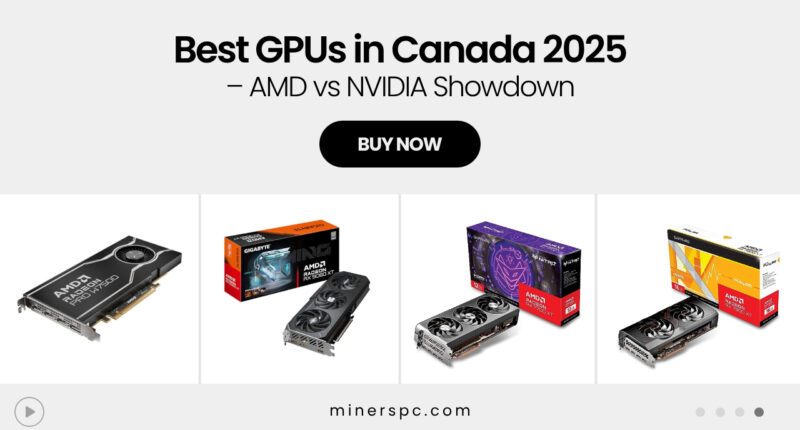In the ever-competitive world of graphics cards, 2025 has proven to be another intense year in the GPU war. Canadian gamers, creators, and professionals are now spoiled for choice with an arsenal of powerful options from both AMD and NVIDIA. But with so many advancements, architectural shifts, and performance benchmarks flying around, one question remains: Who truly leads the pack in Canada this year?
Let’s break it down – feature by feature, performance by performance – and explore how the top AMD and NVIDIA GPUs stack up in 2025 for Canadian users.
The Canadian GPU Landscape: What Matters in 2025?
Whether you’re building a gaming rig in Toronto, editing 8K footage in Vancouver, or training AI models in Montreal, the GPU you choose determines everything from speed to visual clarity to productivity. But Canadian buyers also face regional concerns like availability, winter-proofing airflow, and thermals in closed setups.
In 2025, the key buying factors in Canada are:
- Ray tracing and rasterization performance
- VRAM and future-proofing
- Cooling efficiency and acoustics
- Driver support and stability
- Power draw and PSU compatibility
And AMD has come swinging this year with competitive offerings across all performance tiers, posing a serious challenge to NVIDIA’s long-time dominance.
AMD: Innovation, Value, and Modern Powerhouses
Dominating the Mid to High-End Segment
AMD has doubled down on its RDNA 3 architecture, offering GPUs that rival – and sometimes beat – their NVIDIA counterparts in raw rasterization performance. The Sapphire Nitro+ AMD Radeon RX 7800 XT is a standout, delivering 16GB of GDDR6 memory and impressive frame rates at 1440p and even 4K settings. This makes it an excellent choice for Canadian streamers and content creators who need both muscle and memory.
Expert Insight: The RX 7800 XT models (such as the Sapphire 11330-01-20G and the Pulse variant 11330-02-20G) hit a sweet spot in value and performance. They’re excellent for future-proofing without overspending.
Meanwhile, the Radeon RX 7700 XT models – including both the Nitro+ and Pulse editions – bring 12GB VRAM and robust ray tracing improvements. If you’re upgrading from an RX 5000 series or an older RTX 2000-series card, these are substantial leaps forward.
Budget Options Still Shine
Canada’s entry-level and midrange gaming communities have always leaned towards cost-effective builds, and AMD continues to deliver. The GIGABYTE Radeon RX 7600 and Sapphire Pulse RX 7600 offer excellent 1080p performance with RDNA 3 features, and 8GB of GDDR6 memory – a vital spec for modern AAA titles and future game assets.
Even retro champions like the Radeon RX 580 still serve Canadian DIYers well, especially for older titles, emulation, or casual 1080p gaming setups. Its legacy in budget performance can’t be overstated.
NVIDIA: Leading the Way in AI and Ray Tracing
Despite AMD’s strong surge, NVIDIA continues to push the GPU frontier with its Ada Lovelace architecture and cutting-edge features like DLSS 3.5, frame generation, and industry-leading ray tracing.
For Canadians who prioritize:
- Professional rendering tasks
- AI inference and training workloads
- The latest DLSS upscaling
- Studio drivers and CUDA workloads
NVIDIA still holds a critical edge.
However, with rising demand and tight inventory across major cities like Calgary and Ottawa, high-end NVIDIA GPUs can be hard to source or come with delays. This has led many to consider AMD’s flagship contenders instead.
Creative & Professional Use: AMD’s Pro Line Enters the Arena
It’s not just gamers AMD is targeting. The Radeon Pro W7500 is an exceptional workstation-class GPU with 8GB of GDDR6 memory and robust support for CAD, 3D modeling, and video production workloads. With full-height support and efficient thermals, it’s a welcome alternative to NVIDIA’s Quadro line for professionals needing reliable horsepower in their workstations.
Cooling Matters in Canadian Winters (and Summers)
Canadian systems often face wild seasonal swings, from frigid winters to overheated summer setups in cramped condos. Cooling is crucial, and AMD’s board partners like Sapphire and GIGABYTE have leaned into this with triple-fan designs and optimized airflow.
Take the GIGABYTE RX 9060 XT Gaming OC, a solid performer with PCIe 5.0 support and smart cooling profiles that remain quiet under load. It’s a practical choice for performance builds in Canadian households where acoustic control is essential.
Personal Perspective: Building My 2025 1440p Rig in Toronto
As a longtime gamer and PC enthusiast based in Toronto, I recently upgraded my setup with the XFX Speedster MERC310 Radeon RX 7900 XTX. With 24GB of GDDR6 and exceptional thermal design, I’ve been able to crank up every setting in Cyberpunk 2077 and Alan Wake 2 without breaking a sweat. Pairing it with a FreeSync monitor gave me buttery-smooth gameplay and zero screen tearing.
It’s not just about raw power – it’s the stability, driver maturity, and heat management that won me over. AMD has clearly stepped up, not just in silicon, but in the whole user experience.
Final Verdict: Who Wins in 2025?
For Canadian gamers and creators, AMD has claimed serious ground in 2025.
While NVIDIA still leads in specialized AI applications and DLSS-powered ray tracing, AMD’s value proposition, consistent driver updates, and performance-per-dollar ratio make it the smarter choice for most Canadians.
If you’re focused on high-refresh gaming, 1440p+ performance, or long-term upgrade stability without breaking the bank, AMD’s RDNA 3 lineup is delivering across all fronts.
















![Best Prebuilt PCs in Canada for Work, School & Gaming [2025 Guide]](https://www.minerspc.com/wp-content/uploads/2025/07/best-prebuilt-pcs-in-canada-for-work-school-gaming-2025-guide-260x140.jpg)


